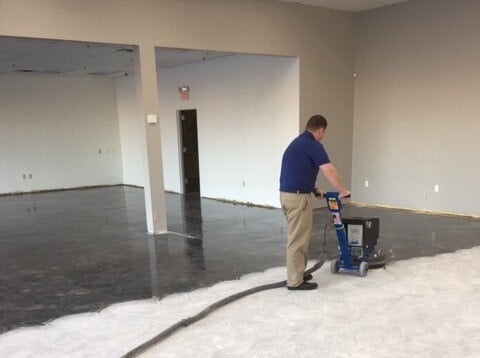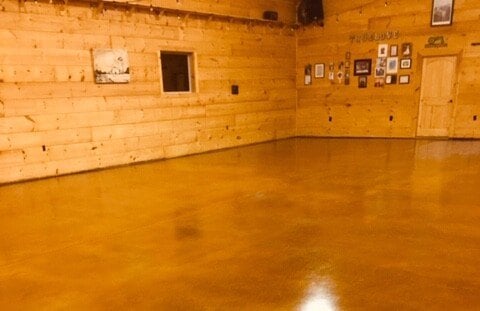If you've ever marveled at the elegant, glossy finish of a concrete floor or patio, chances are you were admiring the effects of a concrete stain. Concrete stains are a popular choice for homeowners and businesses alike, offering a versatile and visually appealing way to transform plain concrete surfaces into stunning focal points.
But what exactly is a concrete stain, and which ones are the best? In this article, we'll dive into the world of concrete stains, exploring their benefits, types, and the top contenders in the market. So, let's get started and discover how you can unlock the true beauty of concrete!
What Is A Concrete Stain?
Concrete stains are specialized coatings designed to enhance and protect concrete surfaces while imparting a vibrant and long-lasting color. Unlike paint, which covers the surface, concrete stains penetrate the concrete, creating a durable bond that withstands wear and tear.
By chemically reacting with the minerals in the concrete, stains produce unique, translucent tones that highlight the natural variations and texture of the surface. This transformative process adds depth, character, and sophistication to any concrete project, whether it's an interior floor, an outdoor patio, or even a decorative concrete countertop.
The Best Types Of Concrete Stains
Staining concrete floors and other surfaces requires the right product for the job. The two main types of concrete stains are acid-based and water-based.

Acid-Based Stains: Unleashing Nature's Artistry
Acid staining is renowned for its ability to create stunning, mottled effects that mimic the look of natural stone or marble.
These stains contain a combination of acid, metallic salts, and pigments that react with the lime content in concrete, resulting in rich, earthy hues. From warm terracottas to cool blue greens, acid stains offer an extensive palette of colors to choose from.
Their translucent nature allows the underlying concrete to peek through, adding depth and complexity to the finished surface. If you're aiming for a rustic, weathered appearance reminiscent of ancient architecture, acid-based stains are an excellent choice.
An acid stain is also highly durable, resisting chipping and UV damage. The color is permanent, so you don't have to worry about fading over time.
Water-Based Stains: Versatility And Ease
Water-based stains, as the name suggests, utilize water as a base instead of acid. They offer a more user-friendly alternative to acid stains, making them an ideal option for DIY enthusiasts or those sensitive to strong odors.
Water-based stains come in a wide range of colors, including vibrant tones and earthy neutrals, allowing you to achieve the desired look for your concrete project. While they may not produce the same marbled effects as acid stains, water-based stains excel in versatility.
They can be layered, mixed, and blended to create custom colors and unique designs. Moreover, water-based stains provide excellent UV resistance, making them suitable for both interior and exterior applications.
Things To Consider When Choosing And Buying Concrete Stains
Type of Stain
Concrete staining using a concrete stain spray, roller, or brush requires the right type of stain for the job. As discussed above, acid-based stains are renowned for their ability to create mottled effects and permanent hues. Water-based stains, on the other hand, are more versatile and user-friendly.
Be sure to choose a stain that is suitable for the intended application — exterior or interior. Exterior concrete stains offer superior UV protection, while interior stains are formulated specifically for indoor use.
Color Selection
Concrete stains come in a wide range of colors, allowing you to customize the appearance of your concrete surface. It's crucial to consider the surrounding environment, architectural style, and your personal preferences when selecting a color.
Keep in mind that the color of the stain may vary depending on the concrete's composition and porosity, so it's advisable to test the stain on a small inconspicuous area before applying it to the entire surface.

Surface Preparation
Proper surface preparation is vital for achieving optimal results with concrete stains. The concrete surface must be clean, free from dirt, oil, grease, and any previous coatings.
Depending on the condition of the surface, you may need to use a concrete cleaner, degreaser, or etching solution to ensure proper adhesion of the stain. Carefully follow the manufacturer's instructions regarding surface preparation to ensure the best outcome.
Horizontal concrete surfaces are particularly prone to staining, so it's important to choose a stain that is designed for horizontal applications.
Durability And Protection
Consider the level of durability and protection required for the concrete surface. Some stains offer added protection against UV rays, water damage, and abrasion.
If the concrete will be exposed to heavy foot traffic, vehicular traffic, or outdoor elements, choose a stain that provides adequate durability and protection to maintain its appearance over time.
An acrylic sealer paired with the best concrete stains for indoor and outdoor surfaces can help protect the surface and enhance its visual appeal.
Application Method
Concrete stains can be applied using various methods, such as brushing, spraying, rolling, or sponging. Consider the size of the area, your level of expertise, and the desired finish when choosing the appropriate application method.
Some stains may require multiple coats, while others may achieve the desired effect with a single application. Make sure to follow the manufacturer's instructions for the recommended application technique.
Maintenance Requirements
Different stains may have varying maintenance requirements. Some stains may require periodic reapplication or the use of specific cleaning products to preserve their appearance. Consider the level of maintenance you are willing to undertake to keep the stained concrete looking its best.
Environmental Considerations
If you have concerns about the environmental impact of the stain, look for low VOC (volatile organic compounds) or water-based stains, which are typically more environmentally friendly compared to traditional acid-based stains.
Budget
Finally, consider your budget when choosing and buying concrete stains. Prices can vary depending on the type, brand, and quantity of the stain. Evaluate the overall cost, including any additional tools or materials required for application, to ensure it aligns with your budget.
FAQ: Answering Your Concrete Stain Queries
How Long Does A Concrete Stain Last?
The longevity of a concrete stain depends on various factors, such as the quality of the stain, surface preparation, and maintenance. Generally, a well-applied concrete stain can last for several years, and periodic resealing can extend its lifespan.
Can I Apply A Concrete Stain Myself, Or Should I Hire A Professional?
While applying a concrete stain is a feasible DIY project, it's crucial to follow the manufacturer's instructions and ensure proper surface preparation.
For complex designs or large-scale projects, hiring a professional may be beneficial to achieve the desired results and ensure a flawless finish.
Will A Concrete Stain Hide Imperfections In The Concrete Surface?
Concrete stains are not designed to mask major imperfections or cracks in the concrete. However, they can help to camouflage minor flaws and enhance the overall appearance of the surface.
It's important to note that proper surface preparation, including cleaning and repairing any damages, is essential for optimal results.
Can I Change The Color Of An Existing Concrete Stain?
Altering the color of an existing concrete stain can be challenging. Acid-based stains chemically react with the concrete, creating a permanent bond.
Water-based stains, on the other hand, offer more flexibility and can be overlaid with different colors. However, it's always recommended to test a small, inconspicuous area before making any significant color changes.

How Do I Maintain A Concrete Stained Surface?
To keep your concrete stain looking its best, regular maintenance is key. Sweep or vacuum the surface to remove dirt and debris, and clean it with a mild detergent and water as needed.
Avoid using harsh chemicals or abrasive cleaners that can damage the stain. Additionally, periodic resealing, typically every 1-2 years, will help protect the surface and maintain its vibrant color.
Can I Use A Concrete Stain On Vertical Surfaces Like Walls?
Yes, concrete stains can be applied to vertical surfaces such as walls, retaining walls, or architectural elements. Vertical staining techniques may vary, and it's advisable to consult the manufacturer's guidelines or seek professional assistance for vertical staining projects.
Conclusion: Unleash Your Creativity With Concrete Stains
Concrete stains offer a world of possibilities when it comes to transforming dull, lifeless concrete surfaces into stunning works of art.
Whether you prefer the rich, earthy tones of acid-based stains or the versatility of water-based stains, there is a wide range of options available to suit your aesthetic preferences and project requirements.
By unlocking the true beauty of concrete, stains can enhance the visual appeal of your indoor and outdoor spaces, creating a unique and personalized atmosphere.
When it comes to choosing the best concrete stain, it's essential to consider factors such as the desired color palette, application ease, and long-term durability. Take the time to research different brands, read reviews, and consult with professionals if needed.
Remember, proper surface preparation and maintenance are vital to ensure the longevity and beauty of your stained concrete surfaces.
3 comments